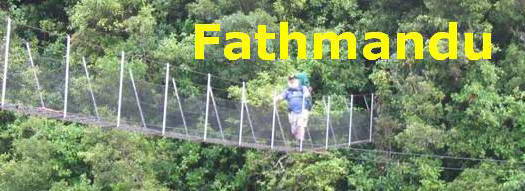
Many thanks for permission to use graphics from their software and toposheets |
 |
|
28 February 2008 Atiwhakatu Track(as far as Mountain House Junction)This track runs off the Mt Holdsworth Loop Track, and follows the Atiwhakatu River as far as the junction with the track to Mountain House Shelter. The other fork goes on across the river and up to the Atiwhakatu Hut and beyond, but this morning all I had time for was a walk as far as the junction. I'll likely be down that way again in September, dv. I headed out from the campground along the clockwise loop track to Donnelly Flats. There's not a lot of spare moisture about but here and there the ferns, mosses and lichens are putting on a good show.
Crown fern (Blechnum discolor) piupiu or petipeti, (though I've never heard the Maori name used for this) is a common carpet in more open areas along here. ( I realised the other day that you can acquire a reasonable reputation for scholarship if you casually toss off the terms blechnum or asplenium. Between the two genera they include a sizeable proportion of the more common ferns.)
Wherever there are teenage males there will be such attempts to demonstrate manhood.
Around to the left we head
and soon, hard right. It's "people" details such as the signpost design on a track that frequently fascinate me - the guy who does the router curlicues around the posts in the Waitaks, for example, and right here we have a guy who likes making rectangular holes. The lettering is precise enough to be computer generated, and the entire sign is painted in a tasteful shade of DoC green with the letters picked out in yellow. And a nice professional touch, the wire reinforcing around the top.
It's pleasant, wide track walking through fairly open forest along here.
The huge buttresses around the beech trees are of interest - apart from their resemblance to illustrations in books of children's fairy tales. You could easily imagine finding one of these in The Wind in the Willows, hosting some middle-class wild creature's comfortable burrow. There's been enough storms through the area to tip over a few of these biggies and typically, for such a large tree, they are very shallow rooted. So the importance of the buttresses as a stabilising agent is obvious.
I can rarely pass a hen and chickens fern - yep, it's another asplenium - without stopping for a photograph. Must share something in common with puppies and kittens.
and here we are at the official start of the Atiwhakatu track.
In 2007, an accumulation of slips and other damage along the lower part of the Atiwhakatu River prompted DoC to re-route the track further up the slope so as to minimise ongoing maintenance. The track they've installed as a replacement makes the Montana Heritage Trail "motorway" pale into insignificance, but fortunately there's enough real track left for the purists and there's some really lovely walking further up. Last time I came through here was November last year, when DoC were just building the track so I'll pop in a few earlier pics for contrast. Here's last November
and here's it looks like today:
We carry on through this for several hundred metres.
The small orchid I have seen elsewhere in the area is well-represented along here. I am no expert, but I'll hazard a guess at either Winika cunninghamii (winika or pekapeka) or Earina autumnalis (raupeka), probably the latter on the basis of its later flowering period. The naming history of winika is of interest. Winika was first named by Solander as Epidendrum pendulum, and was subsequently named for the botanist, Allan Cunningham, and transferred to the genus Dendrobium by John Lindley, another distinguished botanist, who held the chair of botany for more than 30 years at University College, London. More recently (1997), M.A. Clements transferred it to a genus of its own, Winika. It was a cultural as well as a scientific exercise: To quote the authors;
However, the flowering period for winika is December/January, and for raupeka, February to April. Excuse me for learning aloud as it were. So probably we are looking at raupeka.
The motorway goes on
and on. Oy! Get in behind, dog!
|
|